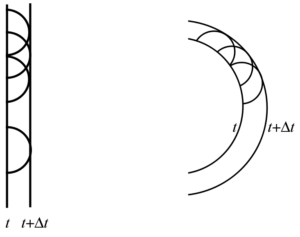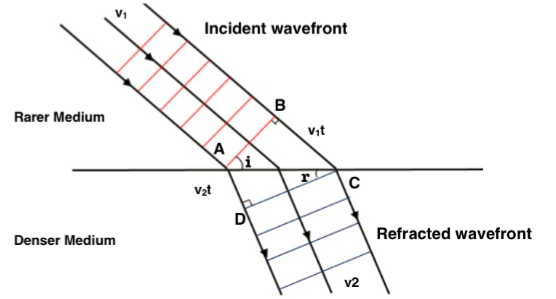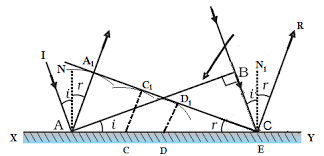Wave Optics: WaveFront and Huygens’s Principle, Reflection and Refraction of Plane Wave at APlane Surface Using Wave Fronts
According to the Huygens’s principle, all points on a wavefront can be regarded as sources of secondary wavelets that are spherical in nature, and their direction of spreading is forward, just like the speed of light. The new wave-front is a tangential surface to the secondary wavelets. In the optics, Huygens’s principle is a statement that all the points of the wavefront of light in the transparent medium or vacuum can be regarded as new sources of wavelets, that is expanding in every direction and the rate of this expanding is dependent on their velocities.

The surface tangent to the wavelet is constituting the new wavefronts and is known as the envelope of wavelet. If the medium is homogenous then the properties will be the same throughout and it permits the traveling of light at the same speed regardless of propagation direction. Here, the three-dimensional envelope of a point source is spherical but in the case of crystals, the envelope is ellipsoidal, For the extending light source, there is an infinite number of point sources and they are considered to be generating the plane wavefront.
Reflection of plane wave at a plane surface using wave fronts
When light is passing from one medium to another medium then its velocity is changed. When the light wave bends while entering another medium is known as refraction. As shown in the diagram below, consider a plane wavefront that is incident on the surface. If V1 is the velocity of the incident ray and V2 is the velocity of a refracted ray of medium 1 and 2 respectively. These velocities are dependent on the medium. According to Hungary’s principle, points A and C are making the source of secondary spherical wavelets.

The t represents the time to reach from point B to C. From point C, a tangent CD is drawn to the sphere so the AD and CD are showing the refracted wavefronts.
Reflection of the Plane Wave at a Plane Surface Using Wave Fronts

Let consider that some rays are coming from a source and are incident on the surface. The wavefronts at this point are the plane waves. In the form of plane wavefronts, the wavefronts are the infinite parallel planes to each other and are having constant amplitude. Let consider a plane wave (AB) that is falling on reflecting the surface. It can be drawn perpendicular to the incident ray. Every point on AB is acting as a source of secondary wavelet. The reflected wavefront, incident wavefront and normal all are lying in the same plane that is perpendicular to the surface of reflection and it is following Huygens’s principle.